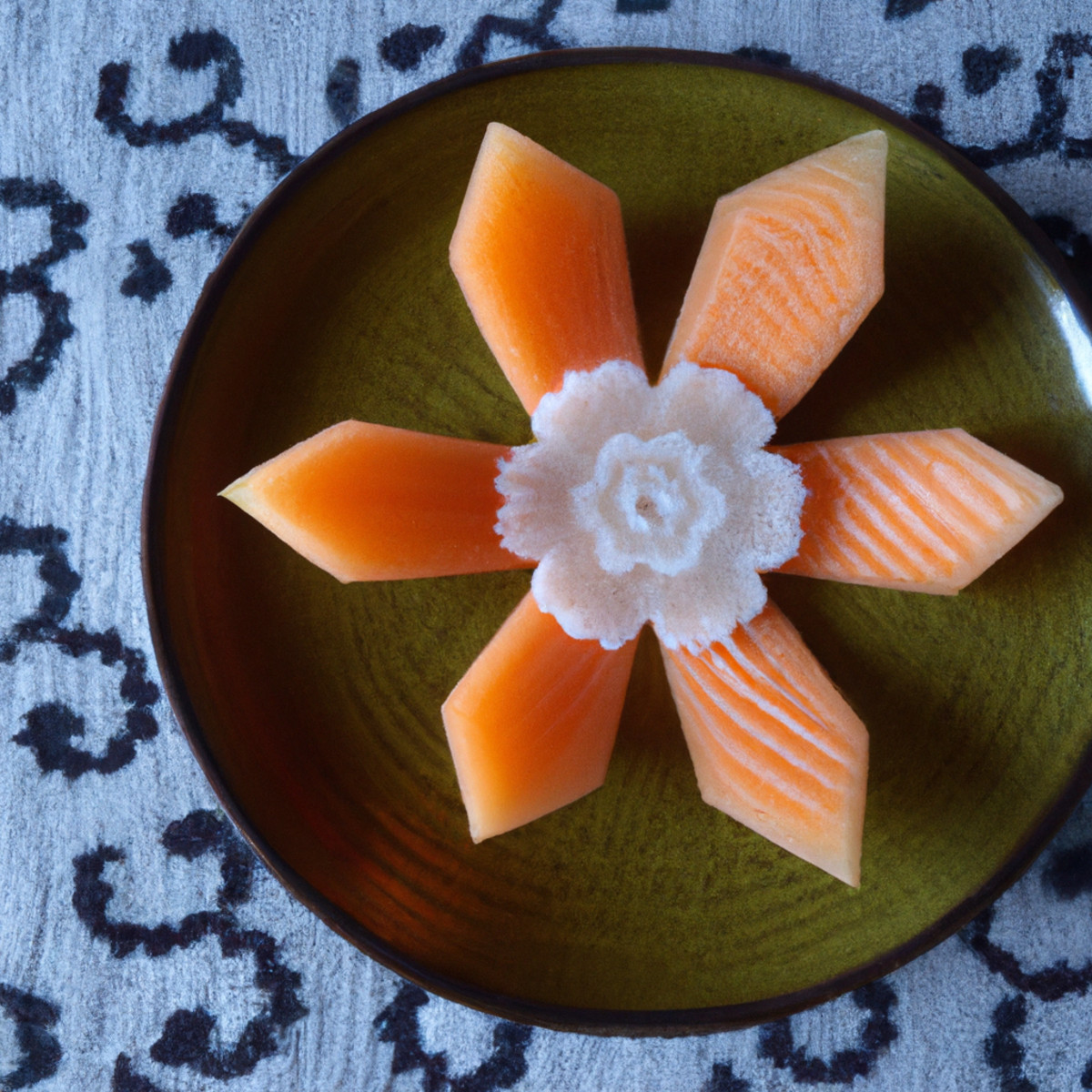Kazarigiri: Japanese Food Cutting at its Finest
Japanese food art is a well-respected part of the country’s culinary tradition.
Mukimono (decorative food garnishing and carving) and Moritsuke (presentation and plating) are two components of the Japanese culinary scene.
But we can’t forget about this special decorative cutting technique called Kazarigiri!

Kazarigiri is a Japanese word for ‘decorative cutting.’ This term refers to a technique of cutting seafood, meat, vegetables, and roots into intricate and complex shapes such as Sakura flowers and leaves.
This article goes over what Kazarigiri is, the history behind this food art technique, and why it’s still relevant today.

Check out our new cookbook
Bitemybun's family recipes with complete meal planner and recipe guide.
Try it out for free with Kindle Unlimited:
Read for freeIn this post we'll cover:
What is Kazarigiri?
In Japan, there’s a huge emphasis on Washoku, which is the traditional Japanese food, and it has been around since ancient times.
The emphasis on the harmony between dishware and serving methods is one of the distinctive features of washoku.
Serving washoku involves the use of kazarigiri (“decorative cutting”) techniques and mukimono, which encompasses the whole art of decorative carving and cutting.
For example, carrots are cut into a sakura shape, or cucumber into a kiku shape. This decorative cutting is used to create dishes that look appealing and unique.
Kazarigiri is both an art form, and an important part of the traditional Japanese food culture.
It can be challenging but also very rewarding – when done correctly, it makes for beautiful dishes that will truly wow your guests.
The important thing to note about Kazarigiri is that it’s a complex cutting and carving technique.
It’s mostly used on meat and seafood, whereas Mukimono is used for fruit and vegetables.
The shapes and patterns used for Kazarigiri include things like cherry blossoms and leaves, which are harder to make than the shapes like cubes and triangles we might be used to seeing.
Vegetables and roots are also used for Kazarigiri but only for intricate and detailed designs.
Kazarigiri is also applied to Kamaboko, which are Japanese fishcakes made out of seasoned fish paste and used as a garnish for dishes like ramen.
In many cases, the Kamaboko is shaped into a flower or little animals like hedgehogs and penguins.
Learn how to make your own kamoboko fish cakes with this easy recipe
Kazarigiri vs Mukimono: what’s the difference?
Japanese food decoration, or mukimono, is a type of art form that involves the decorative cutting of vegetables and other food items.
It is closely related to kazarigiri, which is a type of decorative cutting that involves intricate patterns and designs.
The two terms are often used interchangeably, but there are some differences between them.
Mukimono is typically used to decorate food items such as sushi, sashimi, and tempura.
It involves cutting vegetables and other food items into shapes such as flowers, leaves, and animals.
The shapes are often arranged in intricate patterns and designs. The goal of mukimono is to create an aesthetically pleasing presentation of food.
Kazarigiri, on the other hand, is a type of decorative cutting that involves creating intricate patterns and designs on vegetables and other food items.
It is often used to decorate sushi, sashimi, and tempura.
The goal of kazarigiri is to create a visually appealing presentation of food.
The patterns and designs created by kazarigiri are often more intricate and complex than those created by mukimono.
Kazarigiri and mukimono are similar in that they both involve decorative cutting of food.
The main difference is the type of cut used – while kazarigiri involves more sophisticated cuts, such as flowers or plants, mukimono focuses on simpler shapes like cubes, sticks, or spirals.
Mukimono is often used to cut fruits and vegetables, while kazarigiri is more commonly used with meat.
The end results of both types of cutting are often beautiful and eye-catching dishes that will truly delight your guests.
Kazarigiri and mukimono are both important parts of traditional Japanese food culture.
Learn about the 42 Types of Sushi You Find In Restaurants (Full Guide)
Most popular types of Kazarigiri
There isn’t just one single type of cut used in Kazarigiri.
Sure, chefs like to turn fish like salmon and vegetables like carrots into Sakura shapes, but there are many more popular shapes out there.
Here are some examples of Kazarigiri:
- Sakura-shaped food (cherry blossom patterns can also be carved into radish)
- Plum blossom carrots
- Kamaboko turned into animals and flowers
- Leaves
- Squash and pumpkin carved into leaves and nature patterns
- Lotus roots carved into snowflake shapes
- Peacocks made of kamaboko
- Turtles
- Cucumbers carved into flowers
- Carved radish
- Colorful good luck knots made of carrots and radish
- Haran turned into Mt. Fuji, cranes, and turtles
- Fan-shaped radishes
- Taro shaped into chrysanthemums
- Seaweed shapes into animals
- Carved yuzu
Takeaway
Kazarigiri is an important type of decorative cutting used in traditional Japanese cuisine. Kazarigiri focuses on sophisticated cuts that often resemble plants or flowers.
This type of cutting is used in top-rated fine dining establishments across Japan (& other countries too) to make the food look aesthetically pleasing.
Chefs used special mukimono knives and other tools to create intricate shapes and patterns with their food.
It may take some practice, but the end result is always worth it!
Read next: Japanese chocolate | The popular and unique taste of chocolate in Japan
Check out our new cookbook
Bitemybun's family recipes with complete meal planner and recipe guide.
Try it out for free with Kindle Unlimited:
Read for freeJoost Nusselder, the founder of Bite My Bun is a content marketer, dad and loves trying out new food with Japanese food at the heart of his passion, and together with his team he's been creating in-depth blog articles since 2016 to help loyal readers with recipes and cooking tips.
